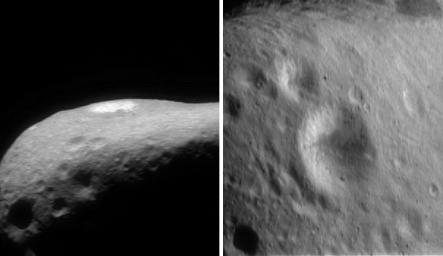
|
April Fool’s Crater
- Click the image above for a larger view
- Full-Res JPEG (605 x 350) (21.5 kB)
- Full-Res TIFF (605 x 350) (159.3 kB)
Caption:
Lighting and viewing geometries make a huge difference in the appearance of Eros' surface features. One of the most striking examples is the 2.7-kilometer (1.68-mile) diameter crater shown in these two images. The image at left, looking at the crater nearly edge-on, was taken February 16, 2000, from a range of 341 kilometers (212 miles). The image at right was taken high over the crater on March 2, 2000, from a range of 226 kilometers (140 miles). In the first image the only visible part of the crater's interior is the far, bright wall, which at the time was well-lit. The lighting, in combination with the particular viewing angle, make the crater appear stunningly bright. In the second view, the brighter material occupies only part of the slightly-shaded interior, greatly reducing the overall brightness contrast between the crater and the surrounding terrain.
Background Info:
Built and managed by The Johns Hopkins University Applied Physics Laboratory, Laurel, Maryland, NEAR was the first spacecraft launched in NASA's Discovery Program of low-cost, small-scale planetary missions. See the NEAR web page at http://near.jhuapl.edu/ for more details.
Cataloging Keywords:
| Name | Value | Additional Values |
|---|---|---|
| Target | 433 Eros | |
| System | Near Earth Objects | |
| Target Type | Asteroid | |
| Mission | NEAR Shoemaker | |
| Instrument Host | NEAR Shoemaker | |
| Host Type | Orbiter | |
| Instrument | Multi-Spectral Imager (MSI) | |
| Detector | ||
| Extra Keywords | Crater, Grayscale | |
| Acquisition Date | ||
| Release Date | 2000-06-10 | |
| Date in Caption | 2000-02-16 | 2000-03-02 |
| Image Credit | NASA/JPL/JHUAPL | |
| Source | photojournal.jpl.nasa.gov/catalog/PIA02495 | |
| Identifier | PIA02495 | |
